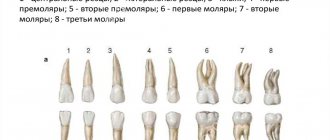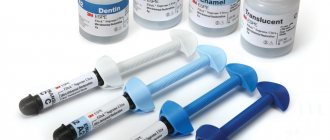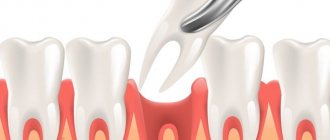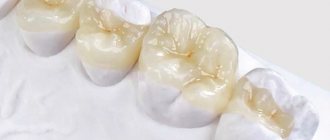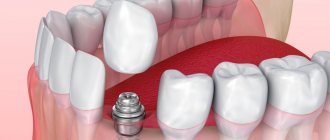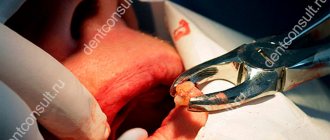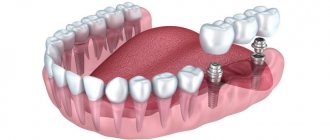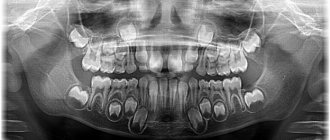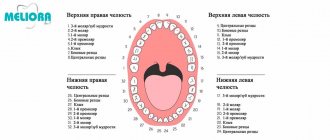The first molars of the chewing group of teeth (6s) are large 2-3-root teeth, the main function of which is the primary mechanical processing of food. They are subject to high chewing loads. Due to their complex structure and location in the row, it is difficult to remove bacterial plaque around the molars, which leads to the development of caries and destruction of dental tissue. The loss of the first molars is fraught with impaired chewing function, displacement of the dentition, impaired occlusion, and other serious problems. Since the upper 6s are located almost close to the maxillary sinuses, the implantation of the 6s in the upper and lower jaws is different.
- When used:
Absence of 1 tooth - Type of anesthesia:
Local anesthesia - Procedure time:
From 15 minutes - Treatment period:
Up to 4 months - Healing period:
Up to 7 days - Age restrictions:
From 18 years old
Why do sixth teeth need restoration more often than others?
The sixth teeth (or first molars according to dental classification) are classified as molars. They are laid at the 5th month of intrauterine development, mineralization begins from the 9th month of the intrauterine period, and continues for another month after the birth of the child. The enamel of the “tooth germs” located in the jaw bone finally matures by 1-2 years. The correct formation of molars depends on the course of pregnancy and childbirth.
Molars do not appear at an early age; they do not have predecessors (baby teeth). They begin to erupt at 5-6 years of age, the first of the permanent radical units. The structure of the first molars differs from other teeth of the chewing group - the maxillary sixes have three roots and four canals, the mandibular sixes have two roots and three canals. These are the largest molars, characterized by a wide tuberous surface.
The chewing group, in particular the first molars, are most susceptible to the destructive effects of bacteria and excessive mechanical stress. This is the main cause of irreversible damage to the tooth structure and its loss.
Typical problems.
NORMALLY, the permanent incisors are located “evenly” in the dentition without “protrusion” or “sagging” to the side. This indicates a harmoniously occurring process of physiological replacement of milk teeth with permanent ones.
If there has been early removal of baby teeth in children and, as a result, permanent chewing teeth are displaced forward, improper closure of the dentition occurs and crowding of teeth appears in the area of the frontal and chewing teeth.
A common problem in the period from 9 to 12 years is poor oral hygiene, which is associated with the characteristics of the psychological development of children. As a result, caries develops in “young” permanent teeth. Most often, the 6th chewing teeth (1st molars) are affected in the area of fissures (natural depressions of the teeth located between the cusps of the tooth).
Fissure caries, remaining unnoticed, develops rapidly and is quickly complicated by inflammation of the nerve of the tooth (pulpitis).
PHOTO: The child's lower permanent incisors erupted in the second row. In this situation, it is necessary to free up space by removing the mobile baby teeth so that the permanent teeth can take the correct position in the dental arch.
Is it necessary to place an implant if there is no six?
The upper and lower sixes, despite their strength, are more susceptible to mechanical stress and exposure to the bacterial environment than other dental units. Molars are one of the first teeth a person loses. The dental system is designed in such a way that almost immediately after the loss of a tooth, the bone tissue in this place begins to decrease.
The absence of the sixth tooth is accompanied by the following problems:
- the abrasion of the frontal group increases;
- the dentition shifts - neighboring units move towards the missing one;
- antagonists move forward - on the opposite jaw the second molar leans forward;
- tilting of the teeth contributes to the appearance of a wedge-shaped defect, exposure of the roots and displacement of the dental axis;
- the chewing load, which previously fell on 6, is redistributed to other units (adjacent premolars, molars);
- occlusion and chewing function are impaired;
- When the occlusion is violated, excessive chewing pressure is created, accelerating bone loss in the area of the missing tooth.
Considering the importance of the six as a supporting chewing unit, you need to immediately think about how to replace it. Implantation is considered a physiological, long-lasting way to replace teeth. Traditional prosthetic methods do not prevent bone loss. Implant-supported dentures are the only way to restore full functionality of the dentition.
How to tell if a tooth is cracked
When a tooth cracks, patients notice a click. However, it is not always possible to see a crack with the naked eye, and pain often appears later. If a tooth is cracked and puts pressure on the gum, soft tissue swelling occurs and inflammation develops.
Bacteria enter the pulp through destroyed enamel. Patients note increased sensitivity to hot/cold foods and complain of pain when closing their jaws. Bad breath appears in the absence of caries. When chewing, the crack enlarges and, without treatment, leads to a tooth fracture or provokes severe pain due to nerve damage.
Important! A brown or black crack on a tooth indicates that food debris and bacteria have entered deep into the crown. Even damage to the enamel that is not noticeable at first leads to the development of caries.
What is the difference between implantation on the upper and lower jaw?
Features of the operation from below
Implantation of the 6th tooth from below is performed using a two-stage method with delayed loading. The implant is implanted using the patchwork method. The crown is installed on the abutment after the artificial root has healed (after 2-4 months). Features of implantation are associated with the anatomical structure of the mandibular structures:
- high jaw bone density - the implant takes root faster, its good primary stability is achieved;
- bone tissue is stronger, therefore it decreases more slowly than in the upper jaw;
- the volume of the mandibular bone is anatomically higher - there are more opportunities to replace the lower tooth without tissue expansion;
- absence of sinuses - there is no risk of injuring the membrane of the maxillary sinus during implantation.
But the trigeminal nerve passes through the base of the lower jaw; if the bone atrophies, it can be damaged (if the technology of the implantation protocol is violated).
Installation of the implant from above
Implantation of the first molars of the upper jaw also has features associated with the anatomy of the jaw structures. The upper teeth are located close to the sinuses (maxillary sinuses), damage to which is accompanied by serious consequences. The maxillary bone is looser and thinner, so it decreases very quickly, and implants take 1-2 months longer to take root than in the lower jaw.
- The choice of method for implanting first molars is a two-stage protocol with a break for osseointegration of the titanium root. The average healing time for upper jaw implants is 4.5 months.
- Since the classical protocol requires sufficient volume and good quality of bone tissue, treatment is often complemented by osteoplastic surgery (sinus lift).
- When making prosthetics, the increased mesiodistal space and the distribution of occlusal forces are taken into account.
Baby teeth in children: loss pattern
We have already said that the loss of baby teeth is associated with the growth of the jaws and the growth of the rudiments of permanent teeth. The rudiments of permanent teeth are located close to the roots of primary teeth, and therefore their development leads to pressure on the roots of temporary teeth (24stoma.ru). This pressure leads to resorption (resorption) of the roots of baby teeth, and as a result – to their mobility and loss. The exception is permanent molars (6-7 teeth), the eruption of which occurs without the loss of temporary teeth, and therefore parents often miss their appearance.
But sometimes permanent teeth erupt incorrectly, and this leads to the fact that the roots of temporary teeth may not undergo resorption for a long time. This situation is especially common in the area of eruption of permanent premolars (4-5 teeth), less often in the area of incisors and canines. In diagram No. 2 you can see the average time frame for when baby teeth change in children. An interesting fact is that in girls, tooth loss begins earlier and progresses faster (compared to boys).
When baby teeth fall out in children: scheme No. 2
Do all baby teeth fall out in children? Please note that temporary teeth can remain in the oral cavity for a much longer time. The main factor causing the loss of a baby tooth is the pressure of the permanent tooth germ on the roots of the baby tooth. Therefore, in the absence of a permanent tooth germ, or its death due to inflammation at the roots of a baby tooth, temporary teeth can remain in the oral cavity much longer than normal. In this case, milk teeth can sometimes be found even in 30-year-old people.
Summary: at what age do baby teeth fall out - loss begins with the central incisors of the lower jaw at 6-7 years of age (in girls, reliably from 6 years of age). Then, at the age of 7-8 years, the central incisors of the upper jaw and the lateral incisors of the lower jaw fall out (and in girls this process reliably begins at the age of 7). If we talk about the age at which milk teeth fall out, then usually this process ends at 12-13 years with the loss of the last milk teeth (second temporary molars).
When you compare the tables for the loss of baby teeth and the eruption of permanent teeth, confusion may arise in your head regarding the name of the teeth. For example, first and second temporary molars and first and second permanent molars. Please note that in place of the fallen first and second temporary molars, permanent premolars (4-5 permanent dentition teeth) will erupt.
Why do you need to build bone tissue?
Increasing bone volume (osteoplasty) is necessary for the primary stabilization of the titanium root. If the height and width of the alveolar ridge are insufficient, the implant simply will not stay in the bone. The method of osteoplastic intervention depends on the clinical picture.
The following methods are used to build bone in the lower jaw:
- Guided bone regeneration.
Increasing the height and width of the alveolar process by replanting osteoplastic material. The surgeon peels off the gum, fills the jaw bone with osteoplastic material, closes it with a barrier membrane and applies sutures. - Splitting of the alveolar process.
Increases bone width. The doctor makes a cut in the center of the ridge, alternately screws spreaders of different diameters into it (from smaller to larger), and fills the resulting space with bone granules. - Bone block transplantation.
An autogenous (taken from the patient) bone block is screwed to the bone, covered with a collagen membrane and sutured. The 6th tooth implant is installed after the block has healed. - Increasing the volume of the maxillary bone.
Because the maxillary structures are located close to the root system of the first molars, a sinus lift is required in 90% of cases. It can be closed or open. The essence of the operation is that the doctor carefully lifts the lower part of the maxillary sinus, fills the resulting space with osteoplastic material and installs a six implant.
How is the 6th tooth removed in Novosibirsk?
The molar extraction procedure is as follows:
- At the first appointment, the doctor diagnoses the condition, both the affected area and the oral cavity as a whole. At this stage, the feasibility of extraction and the possibility of therapeutic treatment are determined.
- Next, an X-ray examination is performed. It allows you to more accurately assess the problem and select appropriate treatment methods.
- If there are diseases of the oral cavity or inflammation, the affected areas are treated.
- On the day of removal, the patient is given an anesthetic.
- Extraction is carried out using two methods: simple extraction or complex operation. Various methods can be used: full traction, when the unit is removed completely, or partial - with crushing and sawing, when individual parts are removed sequentially.
- The surgical field is treated with special means to stop further infection.
- The wound is closed with stitches.
After 5 days, you need to come for an examination to the dentist to determine the condition of the wound and remove the stitches. If you contact the Aesthetics clinic, you will be treated by qualified and experienced doctors. Our center employs professional surgeons, therapists, implantologists, orthodontists, orthopedists and other dentists who have received permission to work. We use exclusively registered drugs and modern equipment.
What should be the postoperative regimen?
After a simple extraction, the patient needs about 10 minutes of rest; after a complex one, it is better to sit in the waiting room for about half an hour.
- After 15 minutes, you must carefully remove the gauze pad that was placed on the operated area.
- For 4 hours, do not put pressure on the jaw - do not eat.
- Throughout the entire rehabilitation period, take prescribed medications on time.
- If you notice any bleeding, you should consult a doctor.
- Consume food and water only at room temperature. Food should not contain a lot of salt and pepper.
- Rinsing should be done as carefully as possible.
After the anesthesia wears off, the pain may increase, which is normal. But if you have a fever and unbearable pain for a long time, you need to come to the clinic for an examination to rule out infection. At Aesthetics we are always happy to help you.
The articles published on the site are for informational purposes only and the services described may not correspond to the list of services provided in the dental clinic. Please check with the administrator for the availability and cost of procedures.
